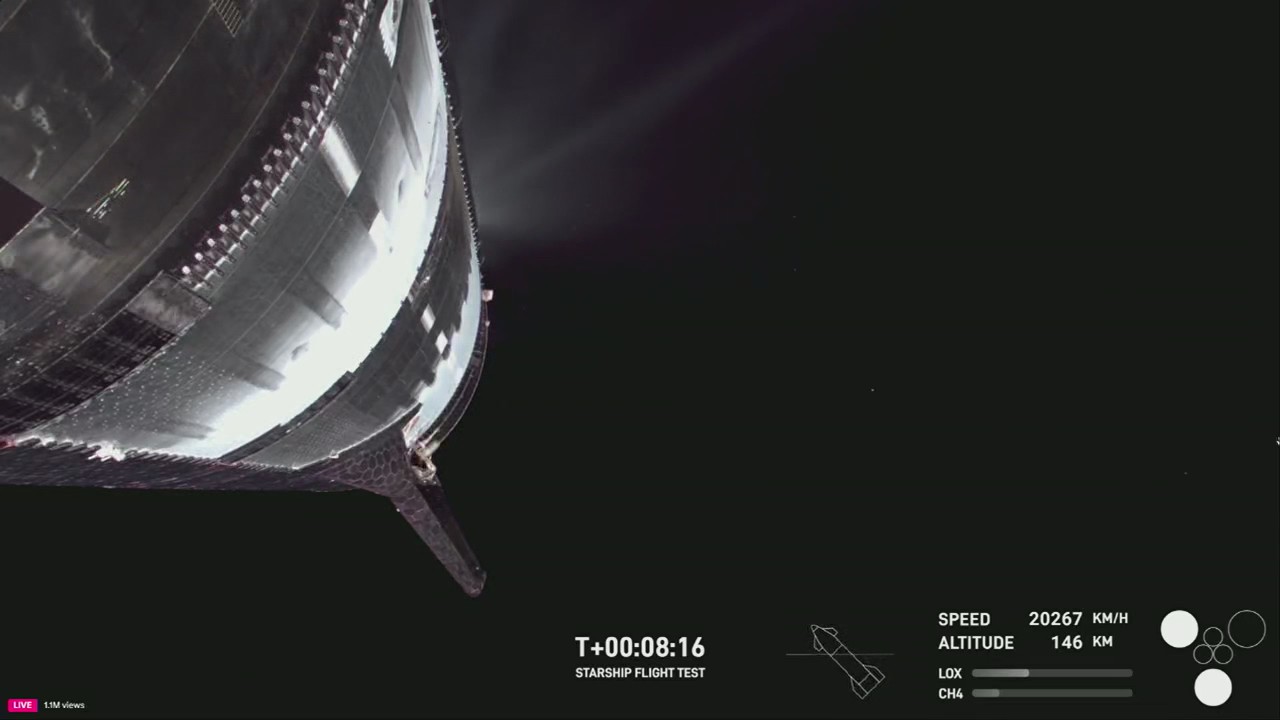SpaceX Starship explosion: FAA opens 'mishap' investigation after failed 8th test flight

SpaceX Starship test ends in explosion off Florida's coast
SpaceX's eighth Starship test flight ended in failure after the rocket lost engines and control before exploding off Florida’s coast.
SpaceX's Starship spacecraft and rocket exploded during its eighth test flight – about eight minutes or so into its flight. The explosion sent fiery debris streaking across the night sky, sparking ground stops at several Florida airports and launching another FAA investigation.
A flight attempt earlier this week was scrubbed due to some last-minute issues.
Starship suffered the same fate during its seventh flight test in January. Following that test flight, SpaceX said it conducted an investigation and made a number of changes ahead of the 8th test flight.
Dig deeper:
- SpaceX plans to build, expand Starship operations in Florida
- Watch: SpaceX Starship explodes, scattering debris over Atlantic Ocean
- Timeline of SpaceX Starship flight tests—and what happened
FAA launches ‘mishap' investigation
What they're saying:
"The FAA is requiring SpaceX to perform a mishap investigation into the loss of the Starship vehicle during launch operations on March 6," the FAA said in a statement.
"During the event, the FAA activated a Debris Response Area and briefly slowed aircraft outside the area where space vehicle debris was falling or stopped aircraft at their departure location. Normal operations have resumed."
What is a mishap investigation?
According to the FAA, a mishap investigation is designed to identify what caused the mishap to happen and tasks the operator – SpaceX, in this case – with developing "corrective actions" to stop it from happening again.
"During an investigation conducted by the operator, the FAA will provide oversight to ensure the operator complies with its mishap investigation plan and other regulatory requirements. In addition, the FAA will coordinate response planning with the National Aeronautics and Space Administration (NASA), the National Transportation Safety Board (NTSB) and with Federal launch ranges operated by the U.S. Space Force, as needed," the FAA said.
How long does a mishap investigation take? The FAA said it depends on the event that caused the investigation, but that it could take weeks, months, or longer.

Breakdown of SpaceX Starship explosion
SpaceX's eighth Starship test flight ended in failure after the rocket lost engines and control before exploding off Florida’s coast. The incident has prompted the Federal Aviation Administration to order ground stops for multiple airports.
Starship 8th test flight: What happened?
SpaceX said Starship successfully lifted off from the Starbase in Texas at 6:30 p.m. Eastern Standard Time (5:30 p.m. Central Standard Time) on March 6.
Starship experienced a normal ascent and separation from the first stage booster, SpaceX said in a post on its website. The Super Heavy Booster was caught successfully by the tower arms back, the third successful catch, SpaceX said.
"Starship continued its ascent to its planned trajectory. Prior to the end of the ascent burn, an energetic event in the aft portion of Starship resulted in the loss of several Raptor engines. This in turn led to a loss of attitude control and ultimately a loss of communications with Starship. Final contact with Starship came approximately 9 minutes and 30 seconds after liftoff," SpaceX said.
What's next:
The FAA and SpaceX will conduct their investigations and release their findings.
"With a test like this, success comes from what we learn, and today’s flight will help us improve Starship’s reliability. We will conduct a thorough investigation, in coordination with the FAA, and implement corrective actions to make improvements on future Starship flight tests."
SpaceX has not listed a date nor time for its expected 9th test flight of Starship.
What is the Starship?
Space's Starship is made up of several components – the spacecraft and the Super Heavy rocket. The goal is to be able to send astronauts and cargo from Earth to the Moon, Mars, "and beyond," according to SpaceX's website. It's designed to be a fully reusable system. SpaceX has reused several boosters, part of its Starlink launches.
According to SpaceX's website, the hope is for Starship to carry up to 100 people on "long-duration, interplanetary flights."
What happened during the 7th flight test?
According to SpaceX, the Starship spacecraft and rocket lifted off at 4:37 p.m. Central Standard Time (5:37 p.m. Eastern Standard Time) from Texas. The Super Heavy rocket was successfully caught, SpaceX said, marking its second-ever catch, SpaceX said.
After the Starship spacecraft separated from the Super Heavy booster, flashes were observed in the rear of the vehicles, near the engines. There was one flash about two minutes after separation, SpaceX said, and a second flash two minutes after that, as well as "sustained fires."
Starship stopped communicating with teams on the ground roughly 8 minutes and 20 seconds into the flight, SpaceX said. Three minutes after that, the spacecraft appeared to break apart and explode across the sky over Turks and Caicos.
"Post-flight analysis indicates that the safety system did trigger autonomously, and breakup occurred within Flight Termination System expectations," SpaceX said.
"The most probable root cause for the loss of ship was identified as a harmonic response several times stronger in flight than had been seen during testing, which led to increased stress on hardware in the propulsion system. The subsequent propellant leaks exceeded the venting capability of the ship’s attic area and resulted in sustained fires."
The Source: The information in this article comes from statements from SpaceX on X and on its website; the FAA following the seventh and eighth flight tests; videos shared with FOX 35; and SpaceX's Starship livestream of both test flights.

